dog
2022«Ø10∑Ó24∆¸
Eight the Dog
Eight the Dog
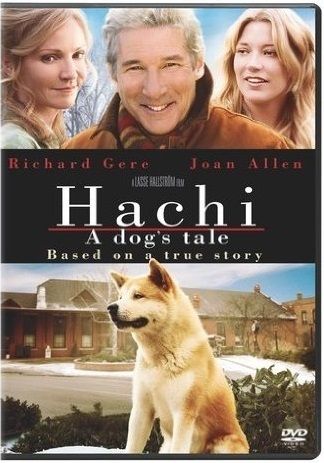
(hachi01.jpg)

(diane02.gif)
Kato, what do you mean by "Eight the Dod"?

(kato3.gif)
It is a dog's name... It literally means the dog called "Eight." °°If it is translated into Japanese, every Japanese knows the dog.
How could it be possible?
There is a dog statue placed in front of Shibuya Station in Tokyo.
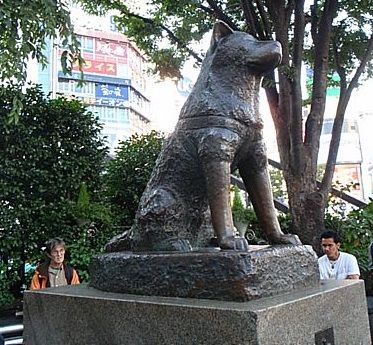
(hachi02.jpg)
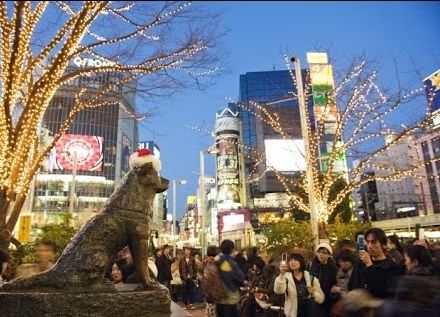
(hachi10.jpg)

So there used to be a real dog called "Hachi" and this statue was made after that dog, wasn't it?

Yes, that's right.
what kind of a dog was it?
Born on November 10, 1923, this dog was called "Hachikō" in Japanese. He died on March 8, 1935. He is remembered for his remarkable loyalty to his owner, for whom he continued to wait for over nine years following his death.
Really?
Oh, yes. During his lifetime, the dog was held up in Japanese culture as an example of loyalty and fidelity. Well after his death, he continues to be remembered in worldwide popular culture, with statues, movies, books, and appearances in various media.
Amazing! I didn't know that.
Eight the Dog
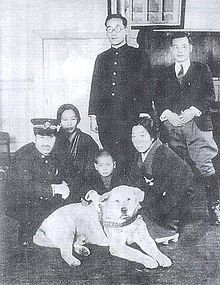
(hachi03.jpg)
In 1924, Hidesaburō Ueno, a professor in the agriculture department at the University of Tokyo, took Hachikō, a golden brown Akita, as a pet.
Ueno would commute daily to work, and Hachikō would leave the house to greet him at the end of each day at the nearby Shibuya Station.
The pair continued the daily routine until May 1925, when Ueno did not return.

(ueno001.jpg)
The professor had suffered a cerebral hemorrhage, while he was giving a lecture, and died without ever returning to the train station in which Hachikō would wait.
Each day, for the next nine years, nine months and fifteen days, Hachikō awaited Ueno's return, appearing precisely when the train was due at the station.
Hachikō attracted the attention of other commuters.
Many of the people who frequented the Shibuya train station had seen Hachikō and Professor Ueno together each day.
Initial reactions from the people, especially from those working at the station, were not necessarily friendly.
However, after the first appearance of the article about him on October 4, 1932 in Asahi Shimbun (one of the national newspapers), people started to bring Hachikō treats and food to nourish him during his wait.
Publication
One of Ueno's students, Hirokichi Saito, who developed expertise on the Akita breed, saw the dog at the station and followed him to the Kobayashi home, the home of Ueno's former gardener, Kuzaboro Kobayashi, where he learned the history of Hachikō's life.
Shortly after the meeting, the former student published a documented census of Akitas in Japan.
His research found only 30 purebred Akitas remaining, including Hachikō from Shibuya Station.
He returned frequently to visit Hachikō, and over the years he published several articles about the dog's remarkable loyalty.
In 1932, one of his articles, published in Asahi Shimbun (literally "Rising Sun Newspaper"), placed the dog in the national spotlight.
Hachikō became a national sensation.
His faithfulness to his master's memory impressed the people of Japan as a spirit of family loyalty to which all should strive to achieve.
Teachers and parents used Hachikō's vigil as an example for children to follow.
A well-known Japanese artist rendered a sculpture of the dog, and throughout the country, a new awareness of the Akita breed grew.
Eventually, Hachikō's legendary faithfulness became a national symbol of loyalty, particularly to the person and institution of Emperors.
Death
Hachikō died on March 8, 1935 at the age of 11 based on his date of birth.
He was found on a street in Shibuya.
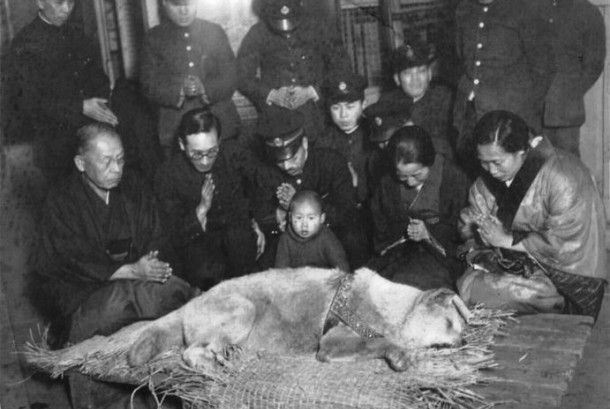
(hachi09.jpg)
In March 2011, scientists finally settled the cause of death of Hachikō: the dog had both terminal cancer and a filaria infection.
There were also four yakitori skewers in Hachikō's stomach, but the skewers did not damage his stomach or cause his death.
Legacy
After his death, Hachikō's remains were cremated and his ashes were buried in Aoyama Cemetery, Minato, Tokyo where they rest beside those of Hachikō's beloved master, Professor Ueno.
Hachikō's fur, which was preserved after his death, was stuffed and mounted and is now on permanent display at the National Science Museum of Japan in Ueno, Tokyo.
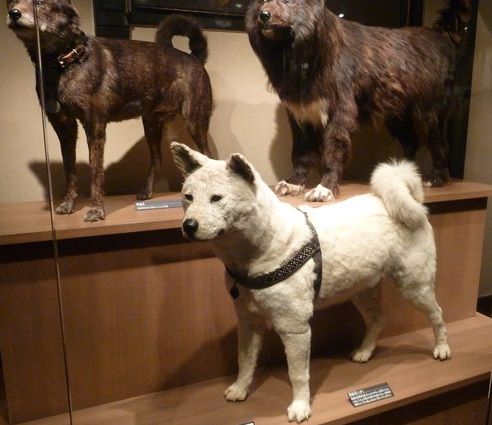
(hachi04.jpg)
Bronze statues
In April 1934, a bronze statue in his likeness was erected at Shibuya Station, and Hachikō himself was present at its unveiling.
The statue was recycled for the war effort during World War II.
In 1948, the Society for Recreating the Hachikō Statue commissioned Takeshi Ando, son of the original artist, to make a second statue.
When the new statue appeared, a dedication ceremony occurred.
The new statue, which was erected in August 1948, still stands and is a popular meeting spot.
The station entrance near this statue is named "Hachikō-guchi", meaning "The Hachikō Entrance/Exit", and is one of Shibuya Station's five exits.
The Japan Times played an April Fools' joke on readers by reporting that the bronze statue was stolen a little before 2:00 AM on April 1, 2007, by "suspected metal thieves".
The false story told a very detailed account of an elaborate theft by men wearing khaki workers' uniforms who secured the area with orange safety cones and obscured the theft with blue vinyl tarps.
The "crime" was allegedly recorded on security cameras.
A similar statue stands in Hachikō's hometown, in front of Ōdate Station.
In 2004, a new statue of Hachikō was erected on the original stone pedestal from Shibuya in front of the Akita Dog Museum in Odate.
After the release of the American movie Hachi: A Dog's Tale (2009) filmed in Woonsocket, Rhode Island, the Japanese Consulate in US helped the Blackstone Valley Tourism Council and the city of Woonsocket to unveil an identical statue of Hachiko at the Woonsocket Depot Square, which was the location of the "Bedridge" train station featured in the movie.
SOURCE: "Hachikō"
From Wikipedia, the free encyclopedia
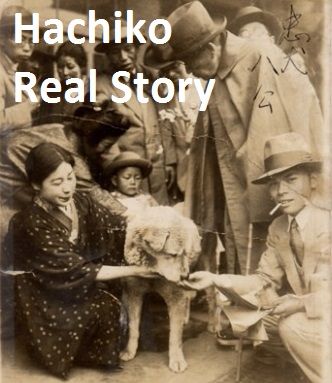
(hachi12.jpg)

I see... So he's become a symbol of loyalty for the Japanese, huh?

You're telling me... Actually, the Japanese still remember Hachiko and love him... As a matter of fact, some people recently placed another statue of both Hachiko and Professor Ueno at the campus of Tokyo University.
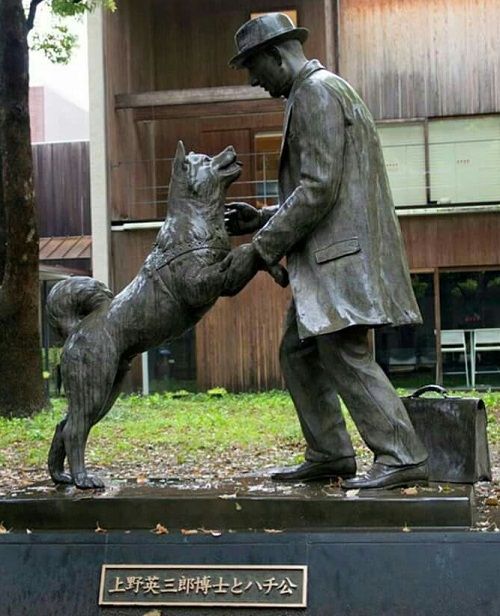
(hachi13.jpg)

But, how come you pick up the dog out of the blue.

Well..., I watched the last movie in the following list.


(lib70924a.png+lib70924a2)
¢£"Actual List"

This is the list of movies I've recently viewed at the Vancouver Public library... Look at the red-rectangled title in the bottom of the list!

I see... So you watched "Hachi" on August 22, huh?
That's right.
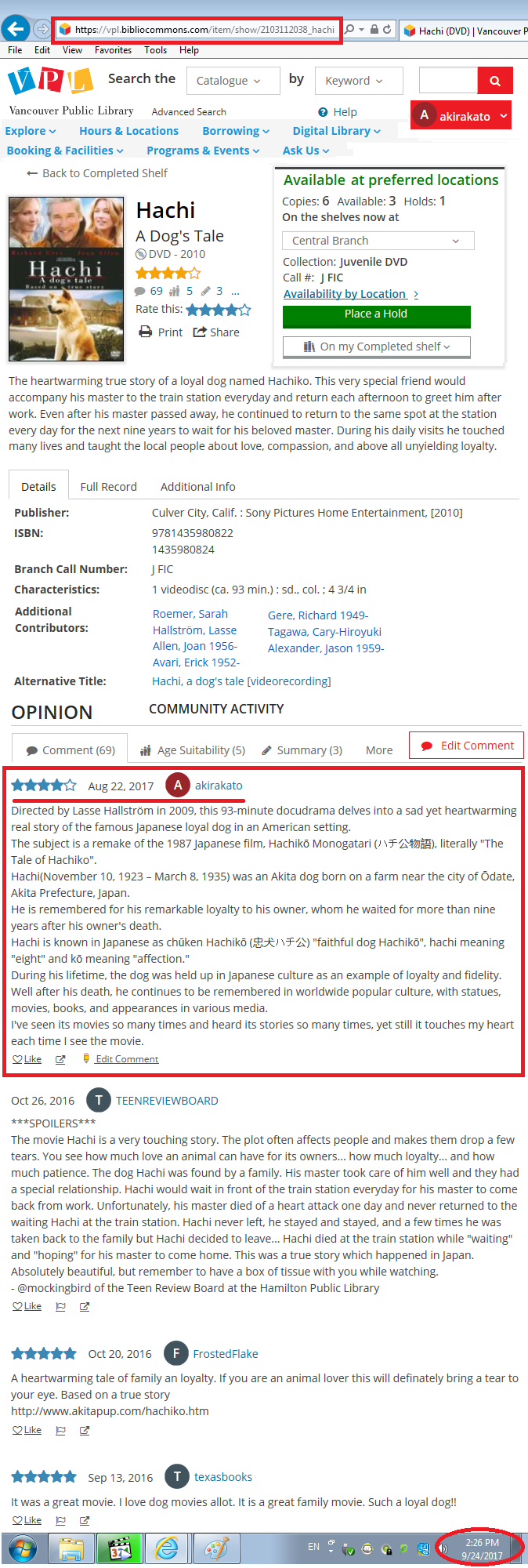
(lib70924b.png)
¢£"Actual Page"

(hachi01.jpg)

After you watched, you jotted down the following comment, huh?
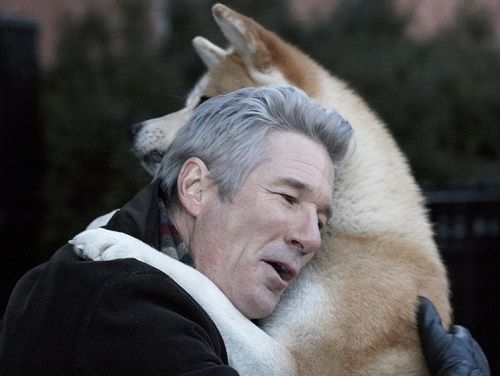
(hachi08.jpg)
Directed by Lasse Hallström in 2009, this 93-minute docudrama delves into a sad yet heartwarming real story of the famous Japanese loyal dog in an American setting.
The subject is a remake of the 1987 Japanese film, Hachikō Monogatari (•œ•¡∏¯ ™∏Ï), literally "The Tale of Hachiko".
Hachi(November 10, 1923 – March 8, 1935) was an Akita dog born on a farm near the city of Ōdate, Akita Prefecture, Japan.
He is remembered for his remarkable loyalty to his owner, whom he waited for more than nine years after his owner's death.
Hachi is known in Japanese as chūken Hachikō (√È∏§•œ•¡∏¯) "faithful dog Hachikō", hachi meaning "eight" and kō meaning "affection."
During his lifetime, the dog was held up in Japanese culture as an example of loyalty and fidelity.
Well after his death, he continues to be remembered in worldwide popular culture, with statues, movies, books, and appearances in various media.
I've seen its movies so many times and heard its stories so many times, yet still it touches my heart each time I see the movie.

Kato, have you really seen so many movies about the dog?

Oh, yes, actually I watched the Japanese version.
How did you like it?
I love it! ... It seems to me much beter than "Hachi (American version)" simply because it reminds me of my hometown... The most heartbreaking scene is as follows:

(hachi14.jpg)

Wow!... I feel like crying...

Seriously?
Oh, yes... very much so... Did you also watch the American version?
Yes, of course, I did.
Kato, tell me about it.
Here it is.
Hachi
Spoiler Alert!
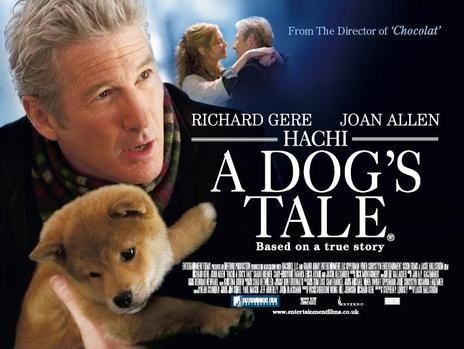
(hachi06.jpg)
Hachi is a story of love and devotion between a dog and a man.
The story is told by Ronnie, the grandson of the man.
He has to give a presentation about a personal hero.
Ronnie's subject is his grandfather's dog, Hachikō.
Despite his classmates laughing he tells how his grandfather, Professor Parker Wilson, finds a lost puppy sent from Japan at the train station and ends up taking it home with the intention of returning the animal to its owner.
He names the Akita puppy Hachikō, after Ken, a Japanese professor, translates a symbol on his collar as 'Hachi'—Japanese for the number 8—signifying good fortune.
Even though they didn't find his owner and his wife, Cate, doesn't think they should keep him, they do.
Over the next year or so, Parker and Hachi become very close.
Parker tries, but Hachi refuses to do dog-like activities like chase and fetch.
One morning, Parker leaves for work and Hachi follows him to the train station and refuses to leave until Parker walks him home.
Later that afternoon, Hachi walks to the station to wait patiently for Parker to return.
Parker is surprised to find Hachi waiting for him, but it becomes a daily routine.
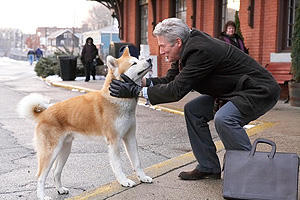
(hachi06.jpg)
One day, Hachi waits patiently as the train arrives, but there is no sign of Parker.
He waits, lying in the snow for hours until Parker's son-in-law Michael comes to get him.
Although everyone tries to tell Hachi that Parker has died (of a cerebral hemorrhage during a lecture in class), Hachi doesn't understand.
Hachi continues to return to the station and wait every day.
As time passes, Cate sells the house and Hachi is sent to live with her daughter Andy, Michael, and their baby Ronnie.
However, Hachi escapes and finds his way back to the station, where he sits at his usual spot.
Andy arrives and takes him home, but after seeing how depressed the dog is she lets him out to return to the station.
Hachi waits every day at the train station and sleeps in the rail yard at night.
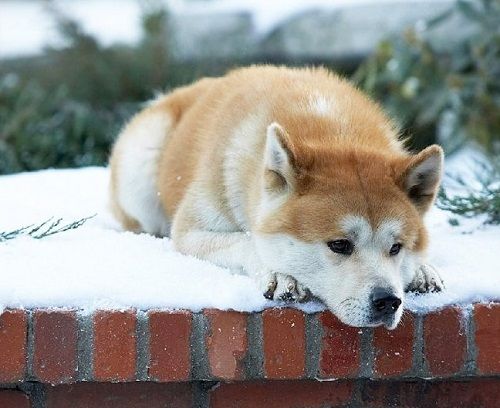
(hachi07.jpg)
He is fed daily by the train station workers that knew the professor.
After seeing a newspaper article about Hachi, Ken visits Hachi.
Cate comes back to visit Parker's grave on the tenth anniversary of his death and meets Ken.
She is stunned to see a now elderly Hachi still waiting.
Overcome with grief, Cate sits and waits for the next train with him.
At home, Cate tells the now ten-year-old Ronnie about Hachi.
Meanwhile, the dog continues waiting until his body can wait no longer, and is last seen lying in the snow, alone and still, although he is comforted by a final vision of Parker finally appearing and picking him up to go, presumably to the afterlife.
Ronnie concludes on why Hachi will forever be his hero and his story has clearly moved the class, with some students holding back tears, including those who had laughed at the beginning.
After school, Ronnie, coming off the school bus, is met by his dad and his own puppy, also named Hachi.
Ronnie and Hachi walk down the same tracks where Parker and Hachi had spent so much time together.
SOURCE:"Hachi: A Dog's Tale"
From Wikipedia, the free encyclopedia

It appears quite different from the Japanese version, doesn't it?

Yes, it does... It can't be the same simply because "Hachi" is now an Americanized pooch... Anyway, the movie turns out to be still good in its own right... And Richard Geer loves the movie himself.
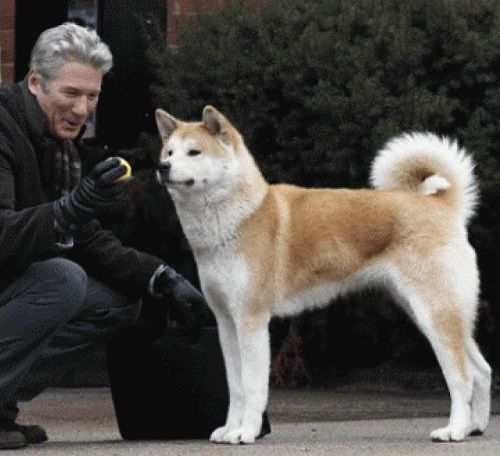
(hachi15.jpg)

Kato, do you think I should watch the film?

Yes, of course, you should because it's free as long as you borrow the DVD from the library.

(laughx.gif)
In any case, there are some people waiting to see this movie. °°So you should reserve the DVD as soon as possible.
Yes, I'll do it right away.

(dianelin3.jpg)
°⁄Himiko's Monologue°€
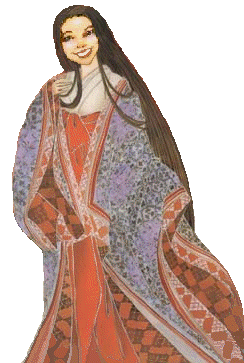
(himiko22.gif)
Kato has watched 1,737 movies at the Vancouver Public Library so far.
When I take a look at the following movie list, I notice a film called "Marley & Me."

(lib70924a2)
¢£"Actual List"
It must be another dog story.
I checked the catalogue page.
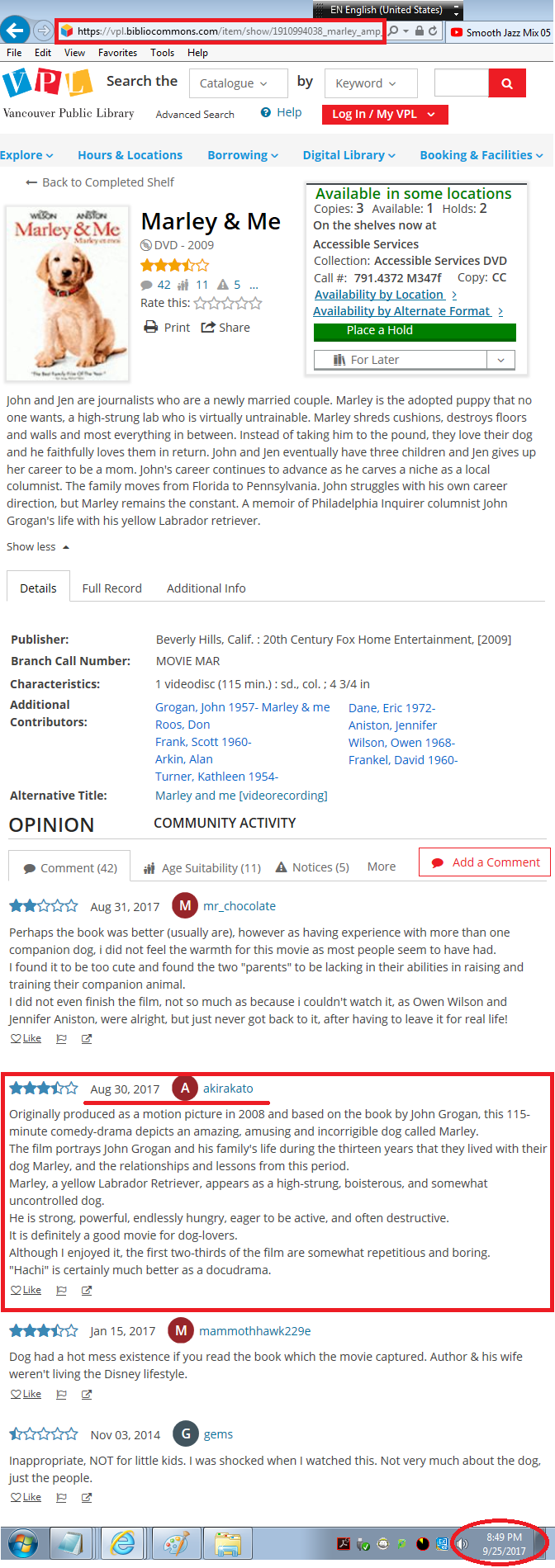
(lib70924c.png)
¢£"Actual Page"
Kato jotted down the following comment:

(marley01.jpg)
Originally produced as a motion picture in 2008 and based on the book by John Grogan, this 115-minute comedy-drama depicts an amazing, amusing and incorrigible dog called Marley.
The film portrays John Grogan and his family's life during the thirteen years that they lived with their dog Marley, and the relationships and lessons from this period.
Marley, a yellow Labrador Retriever, appears as a high-strung, boisterous, and somewhat uncontrolled dog.
He is strong, powerful, endlessly hungry, eager to be active, and often destructive.

(marley07.jpg)
It is definitely a good movie for dog-lovers.
Although I enjoyed it, the first two-thirds of the film are somewhat repetitious and boring.
"Hachi" is certainly much better as a docudrama.
Kato says, "'Hachi' is much better."
Anyway, I past the trailer here.

(marley02.jpg)
It looks amusing and amazing, doesn't it?
I think I'll borrow the DVD.
How about you?
In any case, I expect Kato will write another interesting article soon.
So please come back to see me.
Have a nice day!
Bye bye ...

(hand.gif)

(renge400.jpg)
If you've got some time,
Please read one of the following articles:

(dianesun.jpg)
¢£"Glorious Summer"
¢£"Biker Babe & Granny"
¢£"Genetically Modified"
¢£"Tyrannosaur"
¢£"Love@Magic"
¢£"Yellow Ball"
¢£"Welcome Back"
¢£"Forbidden Love"
¢£"Merry X'Mas"
¢£"Heaven with Mochi"
¢£"Travel Expense Scandal"
¢£"Love@Redemption"

(cook002.jpg)
¢£"JAGEL"
¢£"JAGEL Again"
¢£"Say NO!"
¢£Happy Gal in Canada
¢£Roof of Vancouver
¢£Aftershock
¢£Whiplash
¢£Sex Appeal
¢£Better Off Without Senate
¢£Fire Festival
¢£Sweets@Paris
¢£Scary Quake
¢£MH370 Mystery
¢£Putin's Way
¢£Trump @ Vancouver
¢£Otter & Trump

(juneswim.jpg)
¢£Changeling
¢£Fiddler on the Roof
¢£Flesh and Bone
¢£Maiden's Prayer
¢£Romeo & Juliet
¢£Trump @ Joke
¢£Halloween in Shibuya
¢£Trump Shock
¢£Happy New Year!

(biker302.jpg)
¢£Life or Death
¢£Way to Millionaire
¢£Adele Hugo
¢£Middle Sexes
¢£Romance@Madison
¢£Hacksaw Ridge

(surfin2.gif)

(bare02b.gif)
Hi, I'm June Adams.
Kato is a real movie lover, who tries to watch 1001 movies.
As a matter of fact, he has already accomplished his goal.

(lib50909a.png)
¢£°ÿActual List°Ÿ

(june001.gif)
Kato watched "The Arabian Nights" or "One Thousand and One Nights" as his 1001th movie.
You might just as well want to view it.
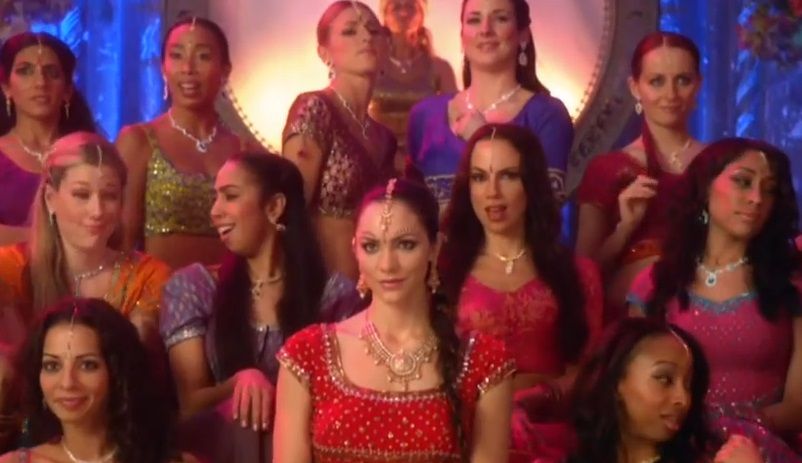
(1001nite.jpg)
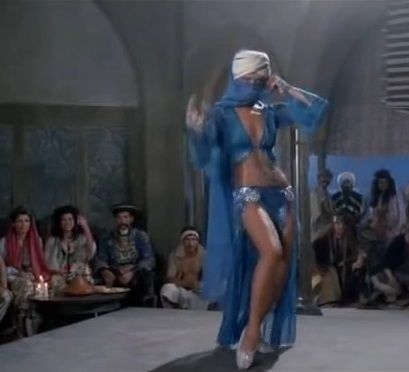
(1001nite10.jpg)

The stories in "the Arabian Nights" were collected over many centuries by various authors, translators, and scholars across West, Central, and South Asia and North Africa.
The tales themselves trace their roots back to ancient and medieval Arabic, Persian, Indian, Egyptian and Mesopotamian folklore and literature.
In particular, many tales were originally folk stories from the Caliphate era, while others, especially the frame story, are most probably drawn from the Pahlavi Persian work Hazār Afsān which in turn relied partly on Indian elements.
What is common throughout all the editions of the Nights is the initial frame story of the ruler Shahryār and his wife Scheherazade and the framing device incorporated throughout the tales themselves.
The stories proceed from this original tale.
Some are framed within other tales, while others begin and end of their own accord.
Some editions contain only a few hundred nights, while others include 1,001 or more.

(bellyan15.gif)

§»§≥§Ì§«°¢∞¶§»•Ì•Þ•Û§ÀÀ˛§¡§ø
•Ï•Û•≤§µ§Û§Œ§™œ√§Ú§Þ§»§·§∆
°ÿ•Ï•Û•≤ ™∏Ï°Ÿ§Ú∫ӧͧާ∑§ø°£
§‚§∑°¢•Ï•Û•≤§µ§Û§Œµ≠ªˆ§Ú§Þ§»§·§∆∆…§þ§ø§§§ §È§–°¢
º°§Œ•Í•Û•Ø§Ú•Ø•Í•√•Ø§∑§∆§Ø§¿§µ§§§Õ°£
¢£°ÿ∞¶§»•Ì•Þ•Û§Œ•Ï•Û•≤ ™∏Ï°Ÿ

(renge730.jpg)
¢£°ÿ∑⁄∞ʬٕø•Í•¢•ª•Û…◊øÕ - æÆ…¥πÁ ™∏Ï°Ÿ
§»§À§´§Ø°¢∫£∆¸§‚∞Ï∆¸≥⁄§∑§ØÃ˚≤˜§À
•Õ•√•»•µ°º•’•£•Û§∑§Þ§∑§Á§¶§Õ°£
§∏§„§¢§Õ°£




(spacer.gif+betty5de.gif)
(hiroy2.png+betty5d.gif)
°ÿ•π•—•Þ°º°°HIRO°°√ÊÃÓ°°∞≠∆¡∂»º‘°Ÿ

(bikini901b.jpg)

(dogs17.gif)

(girlxx.gif)
2014«Ø04∑Ó25∆¸
Amazing Two-legged Pooch
Amazing Two-legged Pooch

(pooch03.jpg)

Kato, have you got an amazing two-legged dog?

Me...? °°Oh, no, I don't have such a mind-boggling pooch.
Then, how come you talk about such an unbelievable dog?
Well ... I've read a newspaper article about unusual dogs.
Pooch Saved from Foreclosed Home

(pooch04.jpg)
Naki'o, a red heeler mix breed, has received four prosthetic limbs in Denver, Colorado.
Naki'o was found in the cellar of a Nebraska foreclosed home with all four legs and its tail frozen in puddles of water-turned-ice.
What frostbite didn't do, a surgeon did, amputating all four legs and giving him four prosthetics.
Two-legged Dog Vid

(pooch05.jpg)
A nine-month-old boxer named Duncan barreled down a beach in Oregon, running full tilt on soft sand into YouTube history and showing more than four million viewers he can revel in a good romp despite lacking back legs.
SOURCE: "Dog days of prosthetics"
Metronews Weekend April 17-20, 2014

Wow! °°Amazing! °°Are these dogs real?

Yes, of course, they are. °°Community papers are not supposed to publish false stories.
So, Kato, you've tried to find YouTube video clips for the above pooches, haven't you?
You're telling me, Diane. °°Here are the amazing video clips:
Naki'o---Bionic Dog
Two Legged Boxer Duncan Lou
Amazing Two hind-legged Dog
Britain's Biggest Dog
Friendly Grizzly Bear
Living With Tigers
Lion Tamer Teenager

So, Diane, how do you like the above video clips?

Just amazing! °°I can't find right words ... Beats the hell out of me.
I'm pretty sure, your brain and nerves have been quite agitated by now. °°So, why don't you take a close look at the following pictures.

(bagel701.jpg)
¢£Croque Monsieur style Bagels

(bagel702.jpg)
¢£Tomato Cheese Bagel Sandwich

(cake703.jpg)
¢£Strawberry Sponge Cake

(bagel704.jpg)

(burger705.jpg)
¢£Fried Minced Meat Hamburger

(sweets706.jpg)
¢£My Favorite Sweets

So, Kato, what about the above pictures?

Aren't you hungry, Diane?
Well ... To tell you the truth, my stomach is rumbling while watching the above pictures. °°Who made all the above?
Mari did.
Did Mari make all the above from scratch?
Yes, she did.
Why?
...'Cause she would like to impress her prospective employers in Vancouver.
No kidding!
Actually, I wrote an article about a bagel shop on Granville Island.

(granvil2.jpg)
°°

(granvil5.jpg)

(granvil3.jpg)

(granvil4.jpg)

(siegel3.jpg)

Denman-san, is Granville Island a famous spot in Vancouver?

Yes, it is. °°Almost all the tourists visiting Vancouver enjoy strolling on Granville Island. °°Mari-chan, I'll take you to the island when you come to this city.
I'd love to visit the island, but how come it is so famous?
Well ... actually, it is not an island. °°It might have been an island a long time ago, but it is now connected to the town. °°In a sense, it is a fashionable waterfront public market with various kinds of shops, stores and restaurants as well as some entertainments such as theaters and exhibition halls. °°If you want to know more about it, click the following link:
¢£°»Grandville Island°…

(granvil6.gif)

Denman-san, is there any particular reason for you to bring up the island?

Good question, Mari-chan! °°Yes, there is a good reason. °°You would be more than happy to visit the island because there is a bagel shop specializing in authentic Montreal-style bagels. °°If you want to know more about the shop, click the link below.

(siegel2.jpg)

(siegel3.jpg)
¢£°»Siegel's Bagels at Granville Island°…

Denman-san, how come you introduce this shop to me?

'Cause this shop makes stuffed bagels with smoked meat.

(siegel4.jpg)

(siegel5.jpg)

Ummmm... looks delicious.

Indeed, it does, eh? °°Mari-chan, I'll tell you what. °°Why don't you make a Japanese-style stuffed bagel with Satsuma-imo or yam?
SOURCE: "Bagels@Granville Island"

Mari has a dream one day she would like to make delicious Japanese-style bagels in Vancouver.

Are you saying that Mari is doing job-hunting while writing articles about her self-made bagels, burgers and sweets?
Yes, that's right. Diane, don't you think she's making such delicious goddies that Vancouverites would be more than happy to have Mari in Vancouver?
I'm pretty sure we'd be more than happy to meet Mari in Vancouver.
Well..., then why don't you jot down a line or two in her blog?
How can I find her blog?
Just under each picture in the above is a link you could click. Mari would be more than happy to see your comment.

(laugh16.gif)
°⁄Himiko's Monologue°€

(himiko22.gif)
A bagel is a bread product, traditionally shaped by hand into the form of a ring from yeasted wheat dough, roughly hand-sized, which is first boiled for a short time in water and then baked.
The result is a dense, chewy, doughy interior with a browned and sometimes crisp exterior.
Bagels are often topped with seeds baked on the outer crust, with the traditional ones being poppy or sesame seeds.
Some also may have salt sprinkled on their surface, and there are also a number of different dough types such as whole-grain or rye.
How to Make Bagels
Bagels have become a popular bread product in the United States, Canada and the United Kingdom, especially in cities with large Jewish populations, many with different ways of making bagels.
Like other bakery products, bagels are available either fresh or frozen, and often in many flavor varieties.
The basic roll-with-a-hole design is hundreds of years old and has other practical advantages besides providing for a more even cooking and baking of the dough.
The hole could be used to thread string or dowels through groups of bagels, allowing for easier handling and transportation and more appealing seller displays.
In any case, I'd like to meet my "Romeo"---a decent man in my future life.
How come I'm always a loner?
I wish I could meet a nice gentleman at the library in my town as Diane met Kato.
Well, they say, there is a way where there is a will.
I hope Kato will write another interesting article.
So please come back to see me.
Have a nice day!
Bye bye ...

(hand.gif)

(renge400.jpg)
If you've got some time,
Please read one of the following articles:

(juneswim.jpg)
¢£"Go Bananas"
¢£"Manwatching"
¢£"Stanley Boardwalk"
¢£"With Your Tiger"
¢£"A Second World"
¢£"Asexual Thought"

(biker302.jpg)
¢£"Stanley 125 Years"
¢£"Sushi @ the Globe"
¢£"Peace@Syria & Pentagon"
¢£"Sweet Memory"
¢£"Unforgettable Movies"
¢£"Typhoon 26"
¢£"Great Luck"
¢£"Diane@World"
¢£"Diane@Spam"
¢£"Sabina"
¢£"Happy New Year"
¢£"Merange & Sabina"
¢£"Beauty in Spa"
¢£"Love @ e-reading"
¢£"Troublesome Slang"
¢£"World Family"
¢£"Mari's Bagels"
¢£"Love & Loyalty"
¢£"Another Cinderella"

(surfin2.gif)

(bare02b.gif)
Hi, I'm June Adames.
The Montreal bagel is a distinctive variety of handmade and wood-fired baked bagel.
In contrast to the New York-style bagel, the Montreal bagel is smaller, sweeter and denser, with a larger hole, and is always baked in a wood-fired oven.
It contains malt, egg, and no salt and is boiled in honey-sweetened water before being baked in a wood-fired oven, whose irregular flames give it a dappled light-and-dark surface color.
How to Make Montreal-Style Bagels at Home
In many Montreal establishments, bagels are still produced by hand and baked in wood-fired ovens, often in full view of the patrons.
There are two predominant varieties: black-seed (poppy seed), or white-seed (sesame seed).
§»§≥§Ì§«°¢∞¶§»•Ì•Þ•Û§ÀÀ˛§¡§ø
•Ï•Û•≤§µ§Û§Œ§™œ√§Ú§Þ§»§·§∆
°ÿ•Ï•Û•≤ ™∏Ï°Ÿ§Ú∫ӧͧާ∑§ø°£
§‚§∑°¢•Ï•Û•≤§µ§Û§Œµ≠ªˆ§Ú§Þ§»§·§∆∆…§þ§ø§§§ §È§–°¢
º°§Œ•Í•Û•Ø§Ú•Ø•Í•√•Ø§∑§∆§Ø§¿§µ§§§Õ°£
¢£°ÿ∞¶§»•Ì•Þ•Û§Œ•Ï•Û•≤ ™∏Ï°Ÿ

(renge730.jpg)
¢£°ÿ∑⁄∞ʬٕø•Í•¢•ª•Û…◊øÕ - æÆ…¥πÁ ™∏Ï°Ÿ
§»§À§´§Ø°¢∫£∆¸§‚∞Ï∆¸≥⁄§∑§ØÃ˚≤˜§À
•Õ•√•»•µ°º•’•£•Û§∑§Þ§∑§Á§¶§Õ°£
§∏§„§¢§Õ°£

(dogs17.gif)

(girlxx.gif)
2012«Ø11∑Ó01∆¸
Eight Bridges
°°°°
°°
Eight Bridges
°°
°°

(hashi900.jpg)
°°

Hi Kato, welcome back to Vancouver!

Nice to be here with you, Diane.
How did you enjoy the stay in Japan?
Oh ..., it was marvellous.°° You see, it was as if I met the first love.
You're over-reacting as usual, Kato.
No, not really. °°I enjoyed the fireworks in October.

Fireworks in autumn!? ... Amazing!

Besides, I loved to taste local dishes at the all-Japan foodfare.

I wish I'd been with you and enjoyed various dishes like a horse.

I know ... I know ... That's the reason I've brought the taste of Japan all the way from Kyoto---the ancient capital of Japan.
The taste of Japan?
Oh yes, I gave you five pieces of Japanese sweets. °°How did you like those?
Well ... They taste quite different from other Canadian sweets. °°What are they called?
They are called "Yatsuhashi" or "Eight Bridges"---if I translate it into English literally.
Yatsuhashi (»¨•ƒ∂∂)

(8hashi2.jpg)
(Baked yatsuhashi)
Yatsuhashi is a Japanese confectionery sold mainly as a souvenir sweet (miyagegashi).
It is one of the best known meibutsu (famous regional products) of Kyoto.
It is made from glutinous rice flour, sugar and cinnamon.
Baked, it is similar to senbei.

(8hashi6.jpg)
(Unbaked yatsuhashi)
Raw, unbaked yatsuhashi (Nama yatsuhashi) has a soft, mochi-like texture and is often eaten wrapped around red bean paste, and may come in a variety of different flavours.
Most notable to the Kyoto area is the black version of this.
The addition of black bean powder to the wrapper gives a distinctive black color.
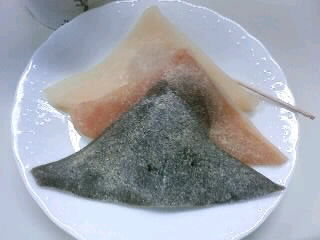
(8hashiw.jpg)
(Black yatsuhashi)
SOURCE: "Yatsuhashi"
From Wikipedia, the free encyclopedia

Ummmm ... quite interesting. °°So, I experienced the taste of Kyoto, didn't I?

Yes, you're telling me.
But I notice that the one you gave me is a little bit diffetent from the unbaked yatsuhashi in the above picture.
... different?
Yes, I mean its color. °°The one I tasted is a bit yellow.
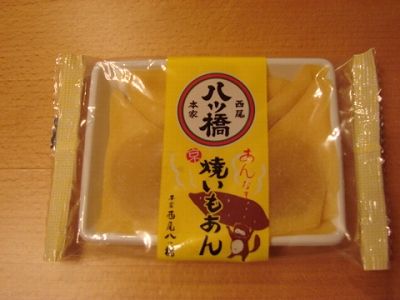
(8hashiy.jpg)

Do you see the difference?

Yes, I do. °°The above pack contains five pieces. °°The actual piece is like this:
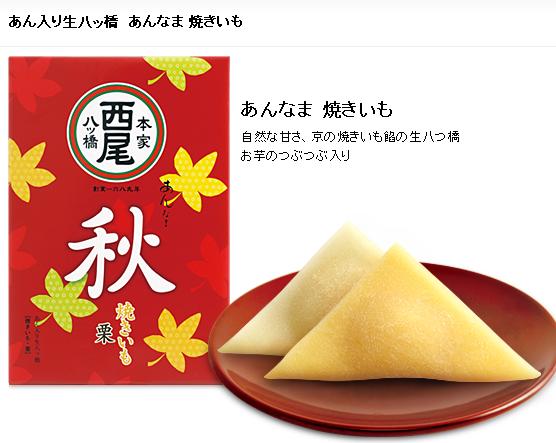
(8hashiz.jpg)

As you said, its color is yellowish.

Why is that?
Well ..., the one you tasted is a real McCoy.
What do you mean?
It was made by the original confectionery factory that was founded in 1689.
Are you saying it was founded 323 years ago?
Yes, you're right on that, Diane.
I can hardly believe it.
If you're in doubt, I'll show you the homepage of the original confectionery.

(8hashix.gif)
¢£"Actual Page"

This confectionery called Nishio (¿æ»¯) was opened 323 years ago as a tea house on the street to Shogo-in (¿ª∏Ó±°) Temple in Kyoto.
Original Confectionery Shop

The Confectionery Shop has a tradition of 323 years.

Wow! °°So I tasted the real McCoy, didn't I?
Yes, you did. °°Diane, did you like the original yatsuhashi?
Yes, of course. °°By the way, how come it is called "Eight Bridges"?
Good question! °°Nobody knows it for sure, but there are two theories. °°One theory goes like this. There was a musician called Yatsuhashi Kengyō (»¨∂∂ ∏°πª; 1614–1685), who lived in Kyoto. The name Kengyō is an honorary title given to highly skilled blind musicians.
Did he play the guitar?
Oh no, he was originally a player of the shamisen (ª∞ã¿˛°ß three-string guitar), but later he learned the koto (‰∑) from a musician of the Japanese court.

(koto800.jpg)

Yatsuhashi is credited as the first musician to introduce and teach the koto to general audiences. He is thus known as the "Father of Modern Koto."

I see.
He changed the limited selection of six pieces to a brand new style of koto music which he called kumi uta. Yatsuhashi changed the Tsukushi goto tunings, which were based on tunings used in gagaku (≤Ì≥⁄: ancient Japanese music), and with this change a new style of koto was born. He adapted the Hirajoshi scale and the Insen scale for the koto, from the shamisen repertoire. °°Yatsuhashi is also credited as the composer of the important koto solo piece Rokudan-no-shirabe (œª√ §Œƒ¥, Music of Six Steps), although he may not actually have composed it himself.
Rokudan-no-shirabe
(œª√ §Œƒ¥)

Ummm ... sounds quite interesting! °°But how come the sweet is related to the musician?

Well ..., they say, the shape of the sweet is just like the shape of the koto (‰∑) the famous Yatsuhashi played.
I don't think both are alike. °°How about the other theory?
There is a classic story called "Ise Monogatari (∞À¿™ ™∏Ï)"---a Japanese collection of waka poems and associated narratives, dating from the 9th century. °°Its chapter nine is called "Kaki-tsubata", in which Yatsuhashi in Mikawa (ª∞≤œπÒ) region is told. The sweet eaten in this tale is somewhat similar to the one made in the Kyoto confectionery factory. °°So the factory owner called it "Yatsuhashi."
I see ... but, Kato, why did you choose these sweets for me?
Good question! °°I have a love story about Yatsuhashi.
Tell me.
Well ... this article is getting long. °°I'll tell you the next time.
Tsk, tsk, tsk, ... I can hardly wait.

(gyaha.gif)
°⁄Himiko's Monologue°€

(himiko22.gif)
I'm glad that Kato introduced "Yatsuhashi" to the world.
As you see, Yatsuhashi is the famous regional product of Kyoto---my hometown where I was born and brought up, and now teaching the tale of Genji (∏ªª· ™∏Ï) at Kyoto Women's College.
When you happen to visit Kyoto, please take a bite of Yatsuhashi---the taste of the ancient capital.
In any case, I hope Kato will write another interesting article soon.
So please come back to see me.
Have a nice day!
Bye bye ...

(hand.gif)

(renge62e.jpg)
If you've got some time,
Please read one of the following artciles:
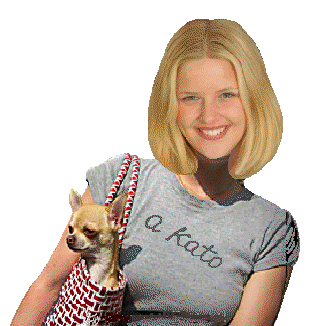
(chiwawa5.gif)
¢£"Madame Riviera and Burger"
¢£"Roly-poly in the North"
¢£"Amazing Grace"
¢£"Diane in Paris"
¢£"Diane in Montmartre"

(ebay5.jpg)
¢£"Diane Well Read"
¢£"Wantirna South"
¢£"Maiden's Prayer"
¢£"Bandwidth"
¢£"Squaw House and Melbourne Hotel"

(vanc700.jpg)
¢£"Tulips and Diane"
¢£"Diane in Bustle Skirt"
¢£"Diane and Beauty"
¢£"Lady Chatterley and Beauty"
¢£"Victorian Prudery"

(sylvia16.jpg)
¢£"Diane Chatterley"
¢£"From Canada to Japan"
¢£"From Gyoda to Vancouver"
¢£"Film Festival"
¢£"Madame Taliesin"
¢£"Happy Days"
¢£"Vancouver Again"
¢£"Swansea"

(juneswim.jpg)
¢£"Midnight in Vancouver"
¢£"Madame Lindbergh"
¢£"Dead Poets Society"
¢£"Letters to Diane"
¢£"Taliesin Studio"

(kimo10.jpg)
¢£"Wright and Japan"
¢£"Taliesin Banzai"
¢£"Memrory Lane to Sendai"
¢£"Aunt Sleepie"
¢£"Titanic @ Sendai"
¢£"Birdcage"

(sylvie121.jpg)
¢£"Roly-poly in the wild"
¢£"Silence is dull"
¢£"Zen and Chi Gong"
¢£"Piano Lesson"
¢£"Dangerous Relation"
¢£"Electra Complex"

(juneswim.jpg)
¢£"Covent Garden"
¢£"Fatal Relation"
¢£"Notre Dame"
¢£"Anne Frank"
¢£"Biker Babe"
¢£"Diane Girdles the Globe"
¢£"Diane in Casablanca"
¢£"Infidelity Neighbourhood"
¢£"Forest Bathing"
¢£"Enjoy Ramen!"
¢£"Sex, Violence, Love"
¢£"Halifax to Vancouver"
¢£"A Thread of Destiny"
¢£"Fujiyama Geisha"
¢£"Beaver Lake"
¢£"God is Near!"
¢£"Holy Cow@Rose Garden"
¢£"Vancouver Earthquake"
¢£"Birthplace"
¢£"KIFF"
¢£"You Love Japan, eh?"

(surfinng9.gif)

(bare02b.gif)
Hi, I'm June Adams.
Ise Monogatari (∞À¿™ ™∏Ï) is a Japanese collection of waka poems and associated narratives, dating from the Heian period.
The current version collects 125 sections, with each combining poems and prose, giving a total of 209 poems in most versions.
The exact date of composition and authorship can only be speculated; the identity of the nameless, idealised central character is likewise ambiguous, but suggested to be Ariwara no Narihira (∫þ∏∂ ∂» ø: 825-880).
Thirty of the poems from Ise Monogatari appear in the Kokin Wakashū (∏≈∫£œ¬≤ŒΩ∏ edited in 905), with similar headnotes, all attributed to Narihira.
The combination of these poems, and the similarity of some events in the tales to Narihira's life, have led to the additional suggestion that Narihira actually composed the work; however, the inclusion of material and events dating after 880 suggests otherwise.

(karuhap8.jpg+bare04e.gif)
§»§≥§Ì§«°¢∞¶§»•Ì•Þ•Û§ÀÀ˛§¡§ø
•Ï•Û•≤§µ§Û§Œ§™œ√§Ú§Þ§»§·§∆
°ÿ•Ï•Û•≤ ™∏Ï°Ÿ§Ú∫ӧͧާ∑§ø°£
§‚§∑°¢•Ï•Û•≤§µ§Û§Œµ≠ªˆ§Ú§Þ§»§·§∆∆…§þ§ø§§§ §È§–°¢
º°§Œ•Í•Û•Ø§Ú•Ø•Í•√•Ø§∑§∆§Ø§¿§µ§§§Õ°£
¢£°ÿ∞¶§»•Ì•Þ•Û§Œ•Ï•Û•≤ ™∏Ï°Ÿ

(renge730.jpg)
¢£°ÿ∑⁄∞ʬٕø•Í•¢•ª•Û…◊øÕ - æÆ…¥πÁ ™∏Ï°Ÿ
§»§À§´§Ø°¢∫£∆¸§‚∞Ï∆¸≥⁄§∑§ØÃ˚≤˜§À
•Õ•√•»•µ°º•’•£•Û§∑§Þ§∑§Á§¶§Õ°£
§∏§„§¢§Õ°£

(dogs17.gif)

(girlxx.gif)
°°
Eight Bridges
°°
°°

(hashi900.jpg)
°°

Hi Kato, welcome back to Vancouver!

Nice to be here with you, Diane.
How did you enjoy the stay in Japan?
Oh ..., it was marvellous.°° You see, it was as if I met the first love.
You're over-reacting as usual, Kato.
No, not really. °°I enjoyed the fireworks in October.

Fireworks in autumn!? ... Amazing!

Besides, I loved to taste local dishes at the all-Japan foodfare.

I wish I'd been with you and enjoyed various dishes like a horse.

I know ... I know ... That's the reason I've brought the taste of Japan all the way from Kyoto---the ancient capital of Japan.
The taste of Japan?
Oh yes, I gave you five pieces of Japanese sweets. °°How did you like those?
Well ... They taste quite different from other Canadian sweets. °°What are they called?
They are called "Yatsuhashi" or "Eight Bridges"---if I translate it into English literally.
Yatsuhashi (»¨•ƒ∂∂)

(8hashi2.jpg)
(Baked yatsuhashi)
Yatsuhashi is a Japanese confectionery sold mainly as a souvenir sweet (miyagegashi).
It is one of the best known meibutsu (famous regional products) of Kyoto.
It is made from glutinous rice flour, sugar and cinnamon.
Baked, it is similar to senbei.

(8hashi6.jpg)
(Unbaked yatsuhashi)
Raw, unbaked yatsuhashi (Nama yatsuhashi) has a soft, mochi-like texture and is often eaten wrapped around red bean paste, and may come in a variety of different flavours.
Most notable to the Kyoto area is the black version of this.
The addition of black bean powder to the wrapper gives a distinctive black color.

(8hashiw.jpg)
(Black yatsuhashi)
SOURCE: "Yatsuhashi"
From Wikipedia, the free encyclopedia

Ummmm ... quite interesting. °°So, I experienced the taste of Kyoto, didn't I?

Yes, you're telling me.
But I notice that the one you gave me is a little bit diffetent from the unbaked yatsuhashi in the above picture.
... different?
Yes, I mean its color. °°The one I tasted is a bit yellow.

(8hashiy.jpg)

Do you see the difference?

Yes, I do. °°The above pack contains five pieces. °°The actual piece is like this:

(8hashiz.jpg)

As you said, its color is yellowish.

Why is that?
Well ..., the one you tasted is a real McCoy.
What do you mean?
It was made by the original confectionery factory that was founded in 1689.
Are you saying it was founded 323 years ago?
Yes, you're right on that, Diane.
I can hardly believe it.
If you're in doubt, I'll show you the homepage of the original confectionery.

(8hashix.gif)
¢£"Actual Page"

This confectionery called Nishio (¿æ»¯) was opened 323 years ago as a tea house on the street to Shogo-in (¿ª∏Ó±°) Temple in Kyoto.
Original Confectionery Shop

The Confectionery Shop has a tradition of 323 years.

Wow! °°So I tasted the real McCoy, didn't I?
Yes, you did. °°Diane, did you like the original yatsuhashi?
Yes, of course. °°By the way, how come it is called "Eight Bridges"?
Good question! °°Nobody knows it for sure, but there are two theories. °°One theory goes like this. There was a musician called Yatsuhashi Kengyō (»¨∂∂ ∏°πª; 1614–1685), who lived in Kyoto. The name Kengyō is an honorary title given to highly skilled blind musicians.
Did he play the guitar?
Oh no, he was originally a player of the shamisen (ª∞ã¿˛°ß three-string guitar), but later he learned the koto (‰∑) from a musician of the Japanese court.

(koto800.jpg)

Yatsuhashi is credited as the first musician to introduce and teach the koto to general audiences. He is thus known as the "Father of Modern Koto."

I see.
He changed the limited selection of six pieces to a brand new style of koto music which he called kumi uta. Yatsuhashi changed the Tsukushi goto tunings, which were based on tunings used in gagaku (≤Ì≥⁄: ancient Japanese music), and with this change a new style of koto was born. He adapted the Hirajoshi scale and the Insen scale for the koto, from the shamisen repertoire. °°Yatsuhashi is also credited as the composer of the important koto solo piece Rokudan-no-shirabe (œª√ §Œƒ¥, Music of Six Steps), although he may not actually have composed it himself.
Rokudan-no-shirabe
(œª√ §Œƒ¥)

Ummm ... sounds quite interesting! °°But how come the sweet is related to the musician?

Well ..., they say, the shape of the sweet is just like the shape of the koto (‰∑) the famous Yatsuhashi played.
I don't think both are alike. °°How about the other theory?
There is a classic story called "Ise Monogatari (∞À¿™ ™∏Ï)"---a Japanese collection of waka poems and associated narratives, dating from the 9th century. °°Its chapter nine is called "Kaki-tsubata", in which Yatsuhashi in Mikawa (ª∞≤œπÒ) region is told. The sweet eaten in this tale is somewhat similar to the one made in the Kyoto confectionery factory. °°So the factory owner called it "Yatsuhashi."
I see ... but, Kato, why did you choose these sweets for me?
Good question! °°I have a love story about Yatsuhashi.
Tell me.
Well ... this article is getting long. °°I'll tell you the next time.
Tsk, tsk, tsk, ... I can hardly wait.

(gyaha.gif)
°⁄Himiko's Monologue°€

(himiko22.gif)
I'm glad that Kato introduced "Yatsuhashi" to the world.
As you see, Yatsuhashi is the famous regional product of Kyoto---my hometown where I was born and brought up, and now teaching the tale of Genji (∏ªª· ™∏Ï) at Kyoto Women's College.
When you happen to visit Kyoto, please take a bite of Yatsuhashi---the taste of the ancient capital.
In any case, I hope Kato will write another interesting article soon.
So please come back to see me.
Have a nice day!
Bye bye ...

(hand.gif)

(renge62e.jpg)
If you've got some time,
Please read one of the following artciles:

(chiwawa5.gif)
¢£"Madame Riviera and Burger"
¢£"Roly-poly in the North"
¢£"Amazing Grace"
¢£"Diane in Paris"
¢£"Diane in Montmartre"

(ebay5.jpg)
¢£"Diane Well Read"
¢£"Wantirna South"
¢£"Maiden's Prayer"
¢£"Bandwidth"
¢£"Squaw House and Melbourne Hotel"

(vanc700.jpg)
¢£"Tulips and Diane"
¢£"Diane in Bustle Skirt"
¢£"Diane and Beauty"
¢£"Lady Chatterley and Beauty"
¢£"Victorian Prudery"

(sylvia16.jpg)
¢£"Diane Chatterley"
¢£"From Canada to Japan"
¢£"From Gyoda to Vancouver"
¢£"Film Festival"
¢£"Madame Taliesin"
¢£"Happy Days"
¢£"Vancouver Again"
¢£"Swansea"

(juneswim.jpg)
¢£"Midnight in Vancouver"
¢£"Madame Lindbergh"
¢£"Dead Poets Society"
¢£"Letters to Diane"
¢£"Taliesin Studio"

(kimo10.jpg)
¢£"Wright and Japan"
¢£"Taliesin Banzai"
¢£"Memrory Lane to Sendai"
¢£"Aunt Sleepie"
¢£"Titanic @ Sendai"
¢£"Birdcage"

(sylvie121.jpg)
¢£"Roly-poly in the wild"
¢£"Silence is dull"
¢£"Zen and Chi Gong"
¢£"Piano Lesson"
¢£"Dangerous Relation"
¢£"Electra Complex"

(juneswim.jpg)
¢£"Covent Garden"
¢£"Fatal Relation"
¢£"Notre Dame"
¢£"Anne Frank"
¢£"Biker Babe"
¢£"Diane Girdles the Globe"
¢£"Diane in Casablanca"
¢£"Infidelity Neighbourhood"
¢£"Forest Bathing"
¢£"Enjoy Ramen!"
¢£"Sex, Violence, Love"
¢£"Halifax to Vancouver"
¢£"A Thread of Destiny"
¢£"Fujiyama Geisha"
¢£"Beaver Lake"
¢£"God is Near!"
¢£"Holy Cow@Rose Garden"
¢£"Vancouver Earthquake"
¢£"Birthplace"
¢£"KIFF"
¢£"You Love Japan, eh?"

(surfinng9.gif)

(bare02b.gif)
Hi, I'm June Adams.
Ise Monogatari (∞À¿™ ™∏Ï) is a Japanese collection of waka poems and associated narratives, dating from the Heian period.
The current version collects 125 sections, with each combining poems and prose, giving a total of 209 poems in most versions.
The exact date of composition and authorship can only be speculated; the identity of the nameless, idealised central character is likewise ambiguous, but suggested to be Ariwara no Narihira (∫þ∏∂ ∂» ø: 825-880).
Thirty of the poems from Ise Monogatari appear in the Kokin Wakashū (∏≈∫£œ¬≤ŒΩ∏ edited in 905), with similar headnotes, all attributed to Narihira.
The combination of these poems, and the similarity of some events in the tales to Narihira's life, have led to the additional suggestion that Narihira actually composed the work; however, the inclusion of material and events dating after 880 suggests otherwise.

(karuhap8.jpg+bare04e.gif)
§»§≥§Ì§«°¢∞¶§»•Ì•Þ•Û§ÀÀ˛§¡§ø
•Ï•Û•≤§µ§Û§Œ§™œ√§Ú§Þ§»§·§∆
°ÿ•Ï•Û•≤ ™∏Ï°Ÿ§Ú∫ӧͧާ∑§ø°£
§‚§∑°¢•Ï•Û•≤§µ§Û§Œµ≠ªˆ§Ú§Þ§»§·§∆∆…§þ§ø§§§ §È§–°¢
º°§Œ•Í•Û•Ø§Ú•Ø•Í•√•Ø§∑§∆§Ø§¿§µ§§§Õ°£
¢£°ÿ∞¶§»•Ì•Þ•Û§Œ•Ï•Û•≤ ™∏Ï°Ÿ

(renge730.jpg)
¢£°ÿ∑⁄∞ʬٕø•Í•¢•ª•Û…◊øÕ - æÆ…¥πÁ ™∏Ï°Ÿ
§»§À§´§Ø°¢∫£∆¸§‚∞Ï∆¸≥⁄§∑§ØÃ˚≤˜§À
•Õ•√•»•µ°º•’•£•Û§∑§Þ§∑§Á§¶§Õ°£
§∏§„§¢§Õ°£

(dogs17.gif)

(girlxx.gif)
